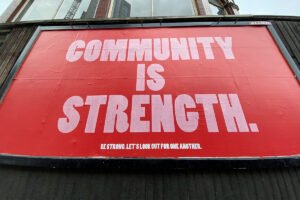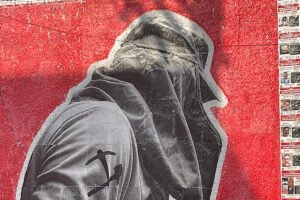
The seeds of a financial system that works for the public are already all around us, from credit unions and loan funds to community bonds and Green Banks. Public banks—created by governments and chartered to serve the public interest—offer a powerful model to advance racial equity, public accountability, and community self-determination.
Locally operated public banks serve as the backbones of a public-serving financial system, partnering with community development financial institutions (CDFIs) and other responsible lenders to channel investments to neighborhoods that mainstream banks have long redlined and neglected.
In New York, the public banking movement has taken root. The New Economy Project and a broad coalition of community, labor, and cooperative groups—alongside community credit unions and loan funds—are organizing for a financial system that serves people, not profits.
We’re closer than ever to realizing this vision—momentum is growing for a pilot program under the Bank of Rochester Act. This initiative would establish the nation’s first deposit-taking municipal public bank, setting a powerful precedent for change.
Despite Wall Street’s influence, the expanding movement for public banking is turning the tide, laying the groundwork for a financial system that truly prioritizes people and communities.
The Road to Public Banking in New York
For decades, private banks driven by profit have funneled public money into harmful practices like fossil fuel development and speculative real estate. Like most states, New York requires by law that cities deposit funds in commercial banks, tying public money to these detrimental practices of Wall Street banks and often leaving communities underinvested and vulnerable to disinvestment and discrimination.
Public banks could break this cycle, moving public money to meet local needs and expand community investment. By leveraging public funds to invest in local communities, public banks can ensure that public money works for the public good. A recent study by economists at The New School’s Center for New York City Affairs demonstrates this capacity, finding that a New York City public bank could create 24,900 permanent jobs and 45,700 temporary construction jobs, build or preserve over 17,000 affordable homes, and generate $5.8 billion in new CDFI lending (including over $1 billion for climate infrastructure), all within its first five years.
Facts like these led the New Economy Project, where I work, to launch the Public Bank NYC coalition in 2018 in partnership with community and labor groups, as well as community development credit unions like the Lower East Side People’s Federal Credit Union.
From the outset, the coalition envisioned public banking not as an end but as a transformative tool to support NYC’s emerging cooperative ecosystem. A public bank would provide responsible loans and investments to bolster community wealth building efforts, such as worker cooperatives, community land trusts (CLTs), and community solar, to name a few. Moreover, it would partner with financial cooperatives (credit unions) already serving historically redlined neighborhoods, amplifying their impact and advancing a democratic economy rooted in equity and self-determination.
Together, the coalition has built a powerful movement for economic justice, with key wins along the way. For example, we helped secure stronger rules for banks eligible to hold New York City deposits; and successfully pressured the city to sever ties with Wells Fargo after the bank discriminated against Black homebuyers. We’ve also used creative public education tools—like the “Worst Banks Awards”—to highlight how big banks perpetuate wealth inequality. To educate and engage New Yorkers, we also produced an animated video that breaks down public banking in sharp and accessible terms.
While greater accountability is essential, we know that banking inequality is systemic and demands systemic solutions. When the city divested from Wells Fargo, for example, the funds only became further concentrated in three other Wall Street megabanks: JPMorgan Chase, Citibank, and Bank of America, which collectively hold more than three-quarters of the city’s deposits.
Moreover, divesting entirely from banks engaged in harmful practices—as some climate groups have rightly called for, in response to the staggering sums banks have funneled into climate-destroying fossil-fuel projects—raises another challenge: Where should the city put its money? Community banks are too small to absorb billions of dollars in municipal deposits. The same holds true for credit unions, which are barred by state law from holding any public deposits, thanks to bank lobbying.
This stark reality makes the need for a public bank crystal clear. Without one, cities remain trapped in a harmful, broken system. A public bank is not just a reform—it’s a necessary foundation for meaningful and lasting change that invests directly in community wellbeing.
A Legislative Path Forward
For years, the Public Bank NYC coalition has organized hearings, pushed for greater transparency about where public money goes, and won incremental reforms. But meaningful transformation requires changing state law. The New York Public Banking Act (S 1754)—modeled in part on California’s groundbreaking 2019 Public Banking Act (AB 857)—would allow public banks to develop and strengthen local economies.
While this statewide bill has broad support, with the majority of state senators now cosponsors, party leaders in Albany have hesitated to advance S 1754, in large part due to banking lobbyists fighting to maintain the status quo.
This is where Rochester comes into play. Last year, the Bank of Rochester Act (A 10134), a bill in the New York State Assembly to establish a Rochester public bank, was successfully passed through the Assembly’s Committee on Banks. While it did not advance further before the 2023–2024 legislative session ended, we are optimistic that it can pass and be enacted in the coming year.
If it does, Rochester’s public bank would become a pilot initiative that could serve as a launching pad for public banking statewide. With especially robust provisions designed to ensure the bank’s success, this initiative presents a promising opportunity to establish a full-fledged public bank in the United States for the first time in a century.
The Bank of Rochester Act: A Bold Step Toward Financial Transformation
The need in Rochester is urgent. A recent report by the Office of the State Comptroller found that Rochester has the fifth-highest child poverty rate of any US city. Children of color in Rochester are disproportionately affected, underscoring the systemic inequities that investment from a city-owned bank could help combat.
Sign up for our free newsletters
Subscribe to NPQ's newsletters to have our top stories delivered directly to your inbox.
By signing up, you agree to our privacy policy and terms of use, and to receive messages from NPQ and our partners.
Designed with robust provisions to ensure financial safety and soundness, the Bank of Rochester would additionally prioritize transparency, accountability, and community needs. Its governance structure empowers public oversight, while its mandate focuses on investments often neglected by Wall Street, such as affordable housing and small business development. By directing resources toward these priorities, the bank would show how public banking can address systemic inequities and drive inclusive economic growth.
The Bank of Rochester would make history as the first full-fledged municipal public bank in the United States. Far from being just a local initiative, it could serve as proof of concept for a statewide public banking framework and a model for transformative finance across New York and the country.
This pilot is the result of bold leadership from a broad coalition of stakeholders, including Mayor Malik Evans, the Rochester City Council—which has unanimously called for a municipal public bank—and the Rochester Public Banking Coalition, led by the Genesee Co-op Federal Credit Union and other community groups. With support from state Assemblymember Harry Bronson and state Senator Samra Brouk, the mayor and city council sent a powerful home rule message to Albany: Rochester is ready to bring public banking to New York so it can more directly address persistent poverty and inequality.
Key to the vision underlying the bank is the partnership model, inspired by the century-old Bank of North Dakota (BND). BND operates as a wholesale lender, supporting North Dakota’s local financial system rather than competing with local banks and credit unions. By working with these institutions, the bank expands access to credit and strengthens the local economy.
This model has proven highly effective: North Dakota boasts the highest concentration of local banks and credit unions in the country. Moreover, BND has played a countercyclical role, focusing on impact rather than maximizing profits and avoiding speculative risks that have destabilized other banks. By emphasizing public policy and economic development goals, BND has helped the state weather economic downturns; create a secondary market for strategic affordable housing, agricultural, and small business loans; and promote long-term economic stability.
Rochester is aiming to replicate this model. To safeguard the new bank’s mission and enable it to hold a far greater share of the city’s public deposits, the Bank of Rochester Act will provide for a targeted state-backed guarantee. This carefully crafted provision addresses challenges that have hindered the launch of similar initiatives elsewhere. With a safe, sound, and workable framework, the Bank of Rochester will be equipped to leverage municipal deposits at scale to meet the city’s pressing needs.
A successful public bank in Rochester could ignite similar initiatives nationwide, inspiring cities and states to reclaim control of their public funds and redirect them toward community-driven priorities.
Building the Future: Realizing the Vision of Public Banking
Achieving the promise of a transformative public banking system in New York will require bold action and sustained commitment. The broad, unified support behind the Bank of Rochester Act reflects years of statewide education, organizing and base-building by the New York State Community Equity Agenda, a coalition dedicated to racial justice and economic democracy. The coalition has been a vital hub for groups advancing structural change—bringing together community groups, worker cooperatives, community land trusts, labor unions, legal services, faith-based organizations, CDFIs, and more.
In 2025, we will continue to broaden support through coalition building across the state, particularly in historically redlined communities. This effort will strengthen both public and political backing by engaging grassroots organizations, labor groups, and community lenders.
Legislative advocacy remains a top priority. The immediate goal is to secure the passage and enactment of the Bank of Rochester Act, followed by organizing during its implementation phase to ensure the bank’s success.
Fortunately, we have key allies like the New York Credit Union Association, which represents over 300 credit unions statewide and has backed the campaign. Moving forward, we must continue to draw on the expertise of technical partners while staying true to the coalition’s transformative vision for public banking and guarding against mission drift.
Public engagement will be critical. Through effective grassroots outreach and political education, communities can understand how public banks work and the tangible benefits they can offer. Clear and accessible communication can transform public banking from an abstract concept into a shared vision.
Beyond Rochester, passing statewide public banking legislation is critical to creating a comprehensive framework that builds on the Rochester pilot’s success. The New York Public Banking Act provides a roadmap to remove structural barriers and empower cities and communities to take control of their financial futures.
At the same time, the Public Bank NYC Coalition is leading a campaign to elevate public banking as a central issue in the upcoming mayoral election. Current Mayor Eric Adams has been unwilling to embrace public banking or challenge Wall Street despite strong support in the city council. New York City’s next mayor must fully embrace and lead the charge for public banking as a structural solution to the city’s affordability crisis—a crisis that is driving far too many working-class New Yorkers out of the city.
Creating a public banking system in New York represents more than just a policy shift—it offers a chance to reimagine finance as a tool for equity, justice, and collective prosperity. In the face of looming federal threats to financial regulation and economic equity—threats that disproportionately impact low-income people, immigrants, and communities of color—local public banks are needed now more than ever.
The Bank of Rochester is poised to lead the way, demonstrating what’s possible when governments put public money to work for the public good. Now is the time to act—turning years of organizing into lasting, transformational change.








